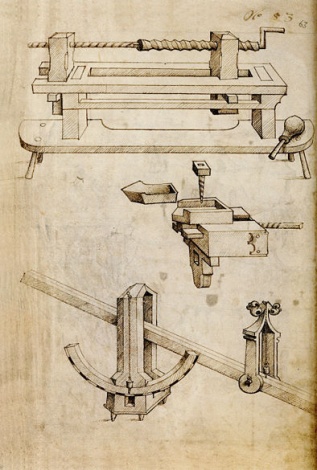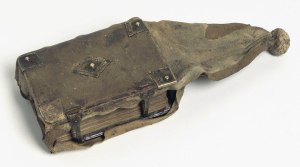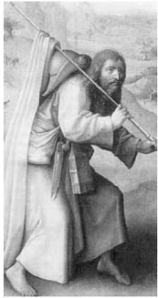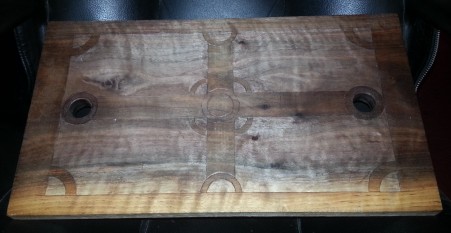Today we’ll be rounding out this accelerated series of the recent competition pieces. I must note that while the body of these posts is copied directly from the documentation I prepared to support the projects, the format has been altered for the blog. If anyone would like to get the “unedited” originals, that could be arranged.
This last piece is the source of the title for this series. I am hardly above making jokes about my own weirdness. I started down the track on whole-number proportioning and dimensioning several years ago. It started with noticing that related pieces of furniture, though not the same actual measurements, tended to have about the same relationships in their dimensions. This first led me to the golden section, then to Vitruvian Design, and finally through additional research to Boethian Design. It really was a vindication when George Walker and Jim Tolpin published “By Hand and Eye” last year. It proved I was not wholly alone in operating under these general principals and my discovery of their historical application. To my knowledge, however, I am currently the only person woodworking by Boethian Design, which makes me still a little bit weirder than the “weird”.
Dovetail Joined Reliquary Box with Sliding Lid, Early 14th Century, Constantinople

Reproduction based on the historical example with different artwork

Reliquary box with scenes of the Life of St. John the Baptist. Cleveland Museum of Art
The original box is extant, in the collection of the Cleveland Museum of Art, Ohio. It was a reliquary box depicting scenes of the life of St. John the Baptist. It exists as a historical curiosity as it is the earliest example of narrow dovetails with mitered corners and a sliding lid in a Medieval European context. These construction elements do not appear together with any consistency in Western Tradition woodworking until the 17th century.
Both the original and inspired piece depict scenes from the lives of their subject. The original depicts, in order: The annunciation of John’s birth to Zacharias and the visitation of Elizabeth and Mary, John’s birth and first bath as well as his name being written on a small tablet. On the other side the story continues with John baptizing Jesus, then a scene of John’s imprisonment and execution.
In the inspired piece, the scenes depict not the life of St John the Baptist, but of the craftsman who built this box. As the life of the craftsman is not over, no more than two of the panels have been filled in. The order of the panels remains the same as the original, however, in that they are “read” from right to left. Typically such progressive story panels are read left to right, but this is another oddity of the original that separates it from almost every other known reliquary. The “first” panel depicts a young Vels being introduced to the Society for Creative Anachronism by Boudicea Ravenhair, the shield in the fore bearing the unit heraldry of the US Army 10th Mountain Division (L.I.), where they were both assigned. The second panel shows a stylized depiction of Vels being given the byname “Viggladi” (meaning: Fond of Warfare, or Battle-Happy) and being inducted into Calontir’s Order of the Iren Fyrd. The rough model for the positioning of Valens and Susannah in this scene is the mosaic of Justinian and Theodora in the Basilica of San Vitale, Ravenna. While surrounded by spears, Vels is offered the symbolic spear of the Order by Susannah.
The reliquary held a relic attributed to Saint John, though which in particular is unknown. It is recorded that two fragments of a skull, a right arm, and locks of blood-clotted hair were kept and venerated in churches and monasteries in Constantinople during this period. It is certainly not the arm, which is a well known gilded relic, but may have housed a bone fragment or lock of hair.
The Cleveland Museum of Art does not have a catalogue reference of the wood used for this piece, they simply have it listed as “wood.” Contacting the curators of the museum gained no further insight. Close inspection of the exposed joinery and worn surfaces of the box indicate a ring-porous hardwood that patinas to a deep brown over time. Given the political and economic situation of the Eastern Mediterranean in the late 13th and 14th centuries, the most likely timber may have been walnut from Northern Italy (specifically, imported by the Genoese to their portage at Galata). After the piece was finished, I recalled that the Acacia was referred to as “St. John’s Wood” and confirmed the likelihood of Vachellia nilotica (Nile Acacia/Locust) being used to construct the original. Trade in the lumber and products of the sap and seed pods remained high throughout the middle ages into the modern era (being the source of Gum Arabic), availability as well as dogmatic relation to the original subject suggests Locust as the most likely wood.
The decorative scenes were painted according to the rules of Ikonographic Tradition: egg tempera and gold leaf over gesso. Aside from modern pigments being largely used, and the small amount of gold leaf being imitation, all traditional techniques for panel painting were followed [See: Cennini].
Rough milling into boards in the original is unclear by the parts evident. That is, there is no indication of the boards being flat sawn or riven from a trunk. Given that both Walnut and Locust are resistant to being riven, sawing seems the most likely first step in preparation of the materials. It is possible the boards were then sawn to rough thickness by either handsaw, water-powered mill, or a reciprocating attachment to a lathe. Flat-sawn walnut was acquired for this project.
Measurement by divider indicates the board thickness of the original box is about 1/6th the height of the box. The Cleveland Museum of Art reports the box is 9.25 x 3.9 x 3.54in. One sixth of 3.5 inches is slightly more than one half an inch. In the reproduction, the boards were thicknessed to about one-half inch by planing.
The boards were then rip sawn to width and crosscut for length at the proscribed dimensions of the original. Given that the length of the box is approximately the distance of a forearm, from the bend of the elbow to the wrist, this was likely the base dimension with the shorter dimensions (3.54 and 3.9 in) being one third (minus the joinery) of the length in height, and one third and a sixth the same in width . This follows a Boethian geometric proportion of 3:1 and 1:1 with a musical accent tone.
 Visual depiction of the “Musical” intervals described in Boethius’ Arithmetica 6th Century, and used as a basis for design and proportion until the rediscovery of Vitruvius’ Ten Books of Architecture in the 15th Century. 3:1 is described as an Octave and a half, while 1:1 is a consonance. By adding 1/6 of one, an accent (tone equivalent to 9:8) creates a harmonic to the base.
Visual depiction of the “Musical” intervals described in Boethius’ Arithmetica 6th Century, and used as a basis for design and proportion until the rediscovery of Vitruvius’ Ten Books of Architecture in the 15th Century. 3:1 is described as an Octave and a half, while 1:1 is a consonance. By adding 1/6 of one, an accent (tone equivalent to 9:8) creates a harmonic to the base.
The groove for the sliding lid created specific complications for executing this design when accompanied by the dovetail joinery. If the joinery were cut across the entire width of the ends, the gap of the groove would be apparent on the outside faces. To cover the groove on the “closed” end of the box, a mitered corner was required. Obviously, the long boards of the sides were cut with miters at either end to allow the determination of which end would be “open” to come later in the process. This order of construction was repeated in the inspired piece. The exposed miter at the open end also allowed the determination of how thick the lid should be. In this case, about one half the thickness of the box sides. The lip between the groove and the top edge of the box was approximated to match the thickness of the side boards. With these elements in place, the layout of the joinery of all elements could be completed, with the “opening” box end being cut flush with the bottom of the groove. The groove itself may have been ploughed with a plough plane, but more likely the edges were sawn and then the waste removed with a narrow chisel. A stair saw was used to set the width of the groove in the Vels’ reliquary, and a narrow chisel used to remove the waste.
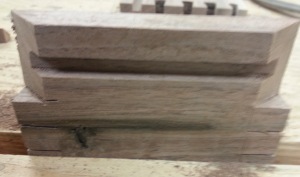
Detail of the layout of mitered dovetail corners and the groove for the lid during construction.
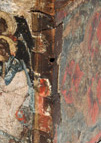
Detail of damaged corner of the original, showing the joinery.
Though definitely triangular, the dovetails show slight rounding rather than distinctly straight edges. This indicates that a turning or fret saw was used to cut the joinery, rather than a plate-saw as would be more common in the coming centuries. The inconsistency has minor impact on the operation of the joint, but that technique is rather tricky to execute with a “wire” bladed saw. Hence, the toolmarks indicate via the of bowing on the tails which type of saw was used.
A coping saw was used in the inspired piece, however practice with this technique and tool combination have yielded superior results to the original maker. The remaining waste was paired away with chisels, as would have been required in the 14th century. The tails were used to layout the corresponding pins and the process continued for the mating boards. The layout and number of the dovetails were determined as slightly less than the thickness of the boards. Each pair of tails and pins were decided to be, on average, one sixth the width of the boards. Given the need for the mitered corners surrounding the groove for the lid, the total number of pins and tails was reduced to four of six possible points of center.
There is no indication of the thickness or construction of the bottom of the box in either the Cleveland Museum’s documentation nor the publicly available photographs. It is inferred that the bottom of the box is of the same thickness as the lid (if not thinner) and is nailed to up into the bottom edges of the sides. Small brads were used to secure a bottom panel to the rest of the case, while the thickness was the same as the lid.
A small nub protrudes from the lid, presumably to make it easier to open the sliding top. A dowel was split and shaved with a chisel from a scrap, then tapped into a snug hole bored in the tongue of the lid. This was reinforced with casein glue and allowed to cure before being trimmed. The actual lid is a piston fit that locks snugly when fully closed.
Following Ceninni’s instructions for painting on panels, which appears to follow from decorative painting tradition of Ikons, the finished box was gessoed on all faces with a traditional mix of crushed gypsum and rabbit skin glue. As the layers were built up, the surface was smoothed with a metal scraper to give a dead flat surface. When sufficient layers were accumulated, the areas for the scenes were stepped off with a set of dividers and marked with a straight edge and knife. The scenes themselves were sketched with a silver-point stylus , then painted with an egg tempera binder of modern water-soluble pigments. Historically this box would have been handed over to an Ikoniker’s Studio for design, guilding, layout and painting. Chronologically, this reliquary was commissioned shortly after the end of the Latin Empire in Constantinople (1204-1261), when the forces of Michael VIII Palaiologos recaptured the city from Baldwin II, a man of French descent. During this period of the 13th century, a great many treasures were carried off or damaged. The techniques used in the replacement of the reliquary may have indicated the height of the art of joinery at the time it was commissioned in the opening years of the 14th century. This suggests that at least a familiarity with this type of construction might have been carried back to Western Europe as early as the Fourth Crusade, though there is no evidence of dovetails (let alone ones so delicate) being used in any context for at least another century in Western Europe.
The final layer of finish that has been layered over the painted sections is glair varnish, made of egg-whites and consistent with traditional Ikon painting of the middle ages. A wad of cloth was used to apply even coats of glair to the painted surfaces. While this will seal and protect the painting, it will not greatly inhibit any further painting that may be done to the piece. At worst, the glair may be scraped off and any lost painting repaired once the glair is removed for adding additional “panels.” Six gessoed panels were protected from varnishing to allow easy access for the future painting of scenes.
On the construction of this box I have no improvements. Over time I do intend to continue filling in panels and decorations, but that is not the purpose of this entry. Being such an oddity of time and place, techniques are used in this piece that are not repeated elsewhere in Europe until after the close of the Renaissance, nor do they seem amply supported to reuse in other similar inspired re-creations. In truth, my motivation to create a piece based off of this original was entirely the novelty of the design and execution of the joinery.
References and Resources:
-Cennini, “Il Libro dell’ Arte”, Translated by Daniel V. Thompson Jr, Dover Publications, NY 1960
-Walker & Tolpin, “By Hand and By Eye,” Lost Art Press, 2013
-Antoine, Beth, “Metalpoint Drawing: The History and Care of a Forgotten Art” bethantoine.com/research/Metalpoint_final.pdf 2007
-Padding, Koen, “A Rational Look at the Classical Italian Coatings” VSA Papers, 2005
And finally a full pictorial gallery of the extant original and the reproduction.
-

-
Blank side awaiting future life events on the inspired piece.
-

-
“Open” end of the box
-
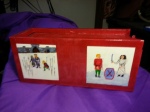
-
First two scenes painted with egg tempered modern pigments.
-

-
Rear corner where a “Ya-But” in the gesso and painting shows indications of the dovetail joinery.
-

-
Lid removed allowing a view of the mitered “open” end and the plowed groove.
-

-
3/4 view of the original. A scene on the right shows John baptizing Jesus in the river Jordan while three attending angels hold Christ’s garments. The last scene shows John’s imprisonment and execution following his denouncement of the adulterous relationship between King Herod Antipas and his brother’s wife, Herodias.
-

-
“Open” end detail of the original
-

-
Top panel/Sliding Lid of the original. Whatever scene may have been painted here appears to have been damaged to unrecognizability.
-

-
The original, showing a combined scene of the annunciation of John’s birth to Zacharias and the visitation of Elizabeth and Mary. Following on the left is a scene depicting John’s birth and first bath as well as his father’s writing down the name of his son on a small tablet.

